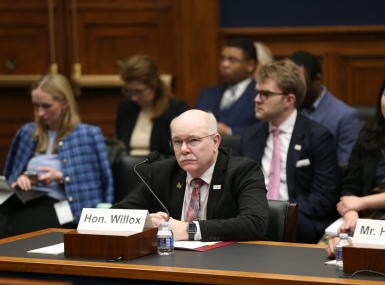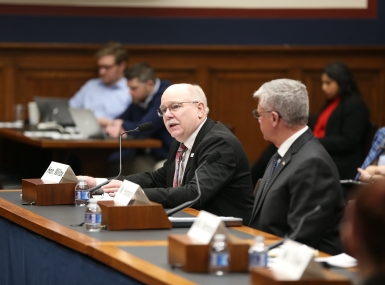Legislative Analysis for Counties: H.R. 3935, the Securing Growth and Robust Leadership in American Aviation Act

Upcoming Events
Related News
In June 2023, the U.S. House and U.S. Senate Congressional committees with jurisdiction over aviation introduced bipartisan versions of bills that would reauthorize funding for the U.S. Department of Transportation’s (USDOT) Federal Aviation Administration (FAA), which initially expired on September 30, 2023.
Background on FAA Reauthorization
Reauthorizations set funding allocations for aviation programs directly impacting county-supported airports including the Airport Improvement Program (AIP), the Essential Air Service (EAS) Program and the Small Community Air Service Development Program (SCASDP).
These traditionally bipartisan FAA reauthorization bills vary in the number of years that are funded. The current reauthorization – the FAA Reauthorization Act of 218 (P.L. 115-253) – which provided a total of $96.7 billion, is over six years (FY 2018 – FY 2023). Typically, new reauthorizations do not occur without help from short-term extensions, which has so far been the fate for this law. Currently, FAA funding is authorized by a third short-term extension of the 2018 act.
County Role in Airports
In addition to our major road and bridge responsibilities, counties also directly support over one-third of public airports that are directly impacted by the FAA reauthorization. In total, counties annually invest over $5 billion in air transportation, directly supporting 34 percent of the nation’s public airports and employing nearly 12,000 employees across the country.
Regardless of ownership or operation, airports and the aviation industry present critical economic development and workforce opportunities in local communities across the country and keep our residents and others connected in every corner of the country.
U.S. House FAA reauthorization bill
On June 9, leadership from the U.S. House Committee on Transportation and Infrastructure (T&I) introduced the Securing Growth and Robust Leadership in American Aviation Act (SGRLAA/H.R. 3935), including T&I Chairman Sam Graves (R- Mo.), Ranking Member Rick Larsen (D-Wash.), Aviation Subcommittee Chairman Garret Graves (R-La.) and Aviation Subcommittee Ranking Member Steve Cohen (D-Tenn).
As introduced, the bill would provide $104 billion in funding for the FAA over five years, a 7.5 percent increase over the current law. Highlights of H.R. 3935 include:
- Increases funding for AIP from $3.35 billion annually to $4 billion annually
- Increases EAS funding and reforms the program, including restricting the length of routes in the contiguous U.S. to 650 miles
- Maintains $10 million in funding for the SCASDP
- First-ever General Aviation Title
U.S. Senate FAA reauthorization bill
Also on June 9, the U.S. Senate Committee on Commerce, Science and Transportation (CST) introduced it’s version of the FAA reauthorization, the FAA Reauthorization Act of 2023 (S. 1939). This bill, which is also bipartisan, was introduced by CST Chair Maria Cantwell (D-Wash.), Aviation Subcommittee Chair Tammy Duckworth (D-Ill.), Subcommittee Ranking Member Jerry Moran (R-Kan.) and Senator Ted Cruz (R-Texas).
The legislation would provide $107 billion over five years from FY 2024 – FY 2028, representing a 10.6 percent increase over current law, and is similar to the House’s in many ways, but includes some key differences, such as authorization levels for EAS and SCASDP, language on “forever chemicals” and different bill titles.
Legislative Outlook
On July 20, the House passed its version of the FAA reauthorization in an overwhelmingly bipartisan vote of 351 to 69. While the House made quick progress due to deals made in committee to only accept nonpartisan or bipartisan amendments, 104 additional amendments were offered during consideration on the House floor. NACo and our coalition counterparts successfully defeated an amendment that would have eliminated funding for the critical Essential Air Service Program.
Unlike the House, the Senate has yet to complete a markup of its legislation due to disagreements over amendments that would have changed the number of flying hours required to obtain a pilot’s license and added slots to the Reagan National Airport, which serves Washington D.C. and the surrounding areas.
Once the Senate CST Committee can advance its version out of committee, the bill will be voted on by the full Senate, where it could be amended again depending on the rule governing the bill on the floor.
Next, differences will be worked out in a conference committee, which is a temporary, ad hoc panel made up of House and Senate members. Once a final version of the legislation is agreed upon, the House and Senate will pass the package and send it to President Biden for his signature.
UPDATE: On March 8, 2024, President Biden enacted a third, short-term funding patch -- the Airport and Airway Extension Act of 2024 (P.L. 118-41) -- for the FAA through May 10. By this date or sooner, lawmakers are on path to release a bipartisan bill that can pass both chambers and be signed into law.
Conclusion
To ensure the continued safe and efficient operation of our nation’s airports, NACo has urged members of Congress to enact a new, long-term FAA reauthorization that supports airport development and air service for urban, suburban and rural communities before the current law expires on September 30. As Congress considers the FAA reauthorization, NACo will continue to track developments and advocate for county priorities throughout this process.
Legislative Analysis for Counties: H.R. 3935
The Securing Growth and Robust Leadership in American Aviation Act
Below is an analysis of the U.S. House version of the FAA reauthorization, as amended in committee and passed by the full House in a bipartisan vote of 351 to 69 on July 20, 2023. Download the analysis here.
SECS. 101 – 104—Authorizations: Authorizes funding for the FAA from the Airport and Airways Trust Fund, including for:
ACCOUNT | 5-YEAR | CURRENT FY 23 | ANNUAL FUNDING FY 2024 – 2028 | CHANGE FROM | ||||
|---|---|---|---|---|---|---|---|---|
Airport | $20 billion | $3.35 billion | $4B | $4B | $4B | $4B | $4B | 19% increase |
Facilities &Equipment | $17.23 billion | $3.7 billion | $3.4B | $3.4B | $3.5B | $3.5B | $3.5B | 8% decrease |
Operations | $66.69 billion | $11.5 billion | $12.7B | $13B | $13.3B | $13.6B | $14B | 10% increase |
Research & Development | $1.3 billion | $214 million | $255M | $261M | $267M | $273M | $279M | 19% increase |
NACo policy: Counties support funding the Airport and Airway Trust Fund at levels that will meet current and future infrastructure needs and allow for the slow of authorized funds without cuts or delays.
SEC. 135—Airport noise officer: Establishes Aviation Noise Officer to liaise with local communities and make recommendations to the Administrator
NACo policy: Counties believe the federal government should continue the research of air and noise pollution caused by civilian and military aircraft, and enforce existing standards, rules and regulations.
SEC. 223—Protecting general aviation airports from FAA closure: Prevents FAA from closing GA airports unless the Secretary can ensure the closure is necessary and does not have unintended impacts
SEC. 265—Low altitude rotorcraft and powered lift operations: Requires Administrator, within 3 years, to establish low altitude (up to 10K feet) routes for helicopters and air taxis
SEC. 401—AIP definitions: Adds definitions for vertiports and heliports, which will allow these projects to be covered by AIP, and adds new eligibilities, including:
- Construction of childcare facilities for airport employees
- Implementation of digital management systems
- Runway, taxiway and apron improvements necessary to sustain commercial air service following a disaster at a primary airport or a GA airport with special FEMA designation
- Any other activity determined by the Secretary to improve airport maintenance, safety, efficiency or capacity
NACo policy: Counties support flexibility for airport sponsors to invest AIP funds for the financing of intermodal transportation facilities that are an integral component to the growth and sustainability of the airport.
SEC. 406—Price adjustment provisions: Allows USDOT to adjust the federal share upwards to account for inflation in AIP agreements already accepted by an airport sponsor
NACo policy: Counties support an increased federal share on airport development projects to help local governments with inadequate local revenues.
SEC. 408—Small airport letters of intent: Beginning in FY 2028, requires FAA to issue $100 million in letters of intent to small airports (currently only large hub airports are eligible), to provide advanced funding for projects, allowing the airport sponsor to be proactive and facilitate better financing
NACo policy: Counties support innovative financing mechanisms that allow local governments and transportation authorities to leverage federal financing for capital projects.
SEC. 411—Apportionments: Makes significant changes to apportionment formulas, including:
- Doubling amounts for enplanement-based apportionments for primary airports
- Increasing the minimum apportionment that a primary airport may receive in one year from $650,000 to $1.3 million
- Adds new apportionment formula for nonprimary commercial service airports on a sliding scale from $150,000 to $1.3 million based on enplanements
- Increases cargo airport apportionments from 3.5 percent to 4 percent of the total amount available to be apportioned in a fiscal year to the sponsors of airports served by cargo-only aircrafts
- Decreases eligibility threshold for cargo airports with annual total landed weight from 100 million pounds to 25 million pounds, which would make more cargo airports eligible for apportionments
- Designates airports co-located with air reserve stations as primary airports under AIP
SEC. 413—Transfer of AIP supplemental funds to formula program: Authorizes $500 million over five years at $100 million annually, significantly decreasing the amount of discretionary funds available from $5.32 billion (also over five years in this case) in current law and makes other changes, including:
- Decreasing amount of grants funds prioritized for non-hub and small hub airports from 50 percent to 25 percent
- Requiring USDOT to prioritize runway or taxiway safety projects for discretionary awards
- Increasing amount of time funds are available from two years to three years
NACo policy: Counties support retaining the existing budget treatment of AIP to allow small and non-hub airports to compete for supplemental funds that would otherwise be diverted to larger airports through AIP formulas should this provision be enacted.
SEC. 414—Small airport fund: Diverts 50 percent of nonprimary entitlement carryover funds to the SAF to account for a reduction in funds flowing into the funds due to changes to PFC “turnbacks,” which refers to the requirement for large and medium hub airports to return a portion of their AIP formula funds to the FAA when charging a PFC; creates new, 5 percent set-asides for the construction of GA hangars and aprons for GA parking, respectively
SEC. 415—Revision of discretionary categories: Revises formulas and eligibilities within AIP discretionary categories and amends environmental set-aside, including by:
- Retaining the maximum percentage of funding that can be spent under the set-aside at 35 percent but decreases the maximum allowed from $300 million to $200 million
- Removing eligibility for state and local governments to carry out the development and implementation of land use compatibility plans and projects related to the use of land around large and medium airports
- Adding language directing FAA to distribute at least two-thirds of set-aside through grants to sponsors of small, medium and large hub airports
NACo policy: Counties believe the federal government should more fully recognize the ability of counties, as area-wide governments, to plan and coordinate aviation with other modes of transportation and to control land use for future airport development. Counties strongly oppose any provisions that would result in local preemption.
SEC. 416—Terminal development: Streamlines requirements for terminal developments largely by removing current restrictions on types and locations of projects, including parking lots
NACo policy: Counties support increased flexibility for public airport sponsors in dedicating available airport grant funds to finance projects determined to be of the highest priority by the sponsoring county or community.
SEC. 425—National priority system formulas: Requires the FAA, within one year of the bill’s enactment, to update its formulas for determining AIP grant priorities assigned to different projects in consultation with airport sponsors of all sizes and assigns the highest priority to projects that “increase or maintain the safety, efficiency and capacity of the aviation system”
SEC. 430—Populous counties without airports: Requires the FAA to includes a new airport in the NPIAS under certain criteria if the airport is located in the most populous county of a state that does not have an airport currently listed in the NPIAS
NACo policy: Counties support increased flexibility for public airport sponsors in dedicating available airport grant funds to finance projects determined to be of the highest priority by the sponsoring county or community.
SEC. 461—Passenger Facility Charge (PFC) application approvals: Expands the eligible use of PFCs to include all airport-related projects by striking language in current law that restricts PFC-funded projects to those that enhance safety and security, reduce noise or increase carrier competition
NACo policy: Counties support increased flexibility for public airport sponsors in dedicating available airport grant funds to finance projects determined to be of the highest priority by the sponsoring county or community.
SEC. 462—PFC authorization pilot program implementation: Streamlines the PFC approval process by implementing a new pilot program that would allow airports to file a notice of intent to impose a PFC rather than an application to do so
Counties strongly support streamlining federal permitting processes to expedite project delivery and ensure critical projects are delivered efficiently and on budget.
SEC. 471—Streamlining consultation process: Removes requirement for USDOT to consult with the
U.S. Department of the Interior and the U.S. Environmental Protection Agency on runway projects when they may impact the environment, including wildlife and air and water quality
SEC. 473—Expedited environmental review and One Federal Decision: Applies One Federal Decision permit streamlining to all airport capacity enhancement projects, terminal development projects, general aviation projects and certain safety projects, including by directing the FAA to act as the lead agency on coordinating timely and efficient environmental review processes
Counties strongly support expanding the application of the One Federal Decision streamlining directive to airport capital projects.
SECS. 476 – 477—Part 150 noise stands update and Reducing community aircraft noise exposure: Requires the FAA to take several actions to reduce unwanted aviation noise in local communities, including by:
- Requiring revision of federal regulations governing airport noise, including through consultation with airport sponsors, users and impacted communities
- Requiring implementation of noise-mitigating flight procedures
- Working with impacted neighborhoods to modify arrival and departure routes
- Discouraging local encroachment of airport property
NACo policy: Counties believe the federal government should continue the research of air and noise pollution caused by civilian and military aircraft and enforce existing standards, rules, and regulations.
SEC. 478—Categorical exclusions: Excludes additional FAA activities from the environmental review required under the National Environmental Policy Act (NEPA) by making them covered a categorical exclusion (CATEX) and creates additional CATEXs, including for:
- Projects receiving less than $6 million in federal funding
- Projects with a total estimated cost of not more than $35 million (adjustable for inflation) where federal funds make up less than 15 percent of the total cost
- Rehabilitation projects for airport infrastructure damaged by a natural disaster
Counties strongly support the expanded use of categorical exclusions in federal agencies consideration of applying NEPA to an infrastructure project.
SEC. 480—Updating presumed to conform limits: Adds airport hangar projects and airport firefighting facilities to list of FAA projects “presumed to conform” with a State Implementation Plan to meet National Ambient Air Quality Standards, as established by the U.S. Environmental Protection Agency
SEC. 483—Aviation and Airport Community Engagement: Requires the FAA to improve community engagement, including by forming an Airport Community of Interest Task Force, where impacted communities, airport sponsors and local governments are each required members, to provide recommendations through annual reports to Congress, beginning in FY 2025, containing recommendations on how to improve current processes, including intergovernmental and community collaboration and engagement
NACo policy: Counties support a strong intergovernmental partnership and believe a coordinated and balanced transportation system supports the interrelationship and connectivity of transportation infrastructure and services across all levels of government, including county/municipal, state and federal transportation assets.
SEC. 485—Third party study on aviation noise metrics: Requires a National Academies study on the advantages and disadvantages of using the Day-Night Average Sound Level metric, which reflects a person’s cumulative exposure to sound over a 24-hour period, compared to alternatives, including for addressing the impacts of nighttime noise
NACo policy: Counties believe the federal government should continue the research of air and noise pollution caused by civilian and military aircraft, and enforce existing standards, rules and regulations.
SEC. 602—Unmanned aircraft system (UAS) test ranges: Establishes a program to enable a broad variety of testing for UAS systems, including counter-UAS systems and solutions
SEC. 604—Public safety use of tethered UAS: Includes non-governmental public safety organizations, such as law enforcement, fire departments, emergency medical services and others, as eligible users of tethered UAS (has physical link to the ground), and restricts the altitude of these drones to 150 feet above the ground unless otherwise permitted by USDOT
NACo policy: Counties believe we should have the authority to regulate certain aspects of UAS operations to ensure public safety and privacy, including but not limited to certain lower levels of altitude, time-and-day of operation restrictions, and enforcement capabilities.
SEC. 618—UAS use in wildfire response: Directs the FAA to work with the U.S. Forest Service to develop a plan to allow public entities to use UAS in wildfire response efforts, including detection, mitigation and suppression
SEC. 620—Drone infrastructure inspection grant program: Authorizes $50 million in appropriations over five years for a new grant program where counties and other eligible entities can use awards to facilitate the use of drones in public infrastructure projects, such as bridge inspections, where they increase efficiency and safety and reduce costs:
FY 2024 | $2 million |
|---|---|
FY 2025 | $12 million |
FY 2026 | $12 million |
FY 2027 | $12 million |
FY 2028 | $12 million |
- 50 percent federal cost share (up to 75 percent with a waiver)
- Requires FAA to prioritize applications that propose to carry out a critical project in any community, including rural, and that address a safety risk in the “inspection, operation, construction, maintenance or repair of critical infrastructure”
- Funds may also be used to contract services
Counties strongly support the Drone Infrastructure Inspection Grant Program that will allow local officials to safely and effectively survey our critical infrastructure assets, including the 38 percent of bridges across the country that are county-owned.
SEC. 685—AIP eligibility for certain spaceport infrastructure: Allows airports that are also spaceports to use AIP funds to repave their entire runway should there be a commercial transportation need for such size
SEC. 750—Consideration of small hub control towers: Directs the FAA to prioritize federally owned air traffic control towers that at least 50 years old when selecting replacement projects to award
SEC. 771—Essential air service (EAS) reforms: Makes reforms to EAS, including:
- Reduces the overall passenger subsidy cap from $1,000 to $500
- Adds 650-mile restriction on the length of EAS routes with the exception of in Alaska and Hawaii (airlines entering into a contract before the date of enactment of this legislation, or that remain in effect on the date of enactment, are exempted until 2028)
- Adds 5 percent cost share for air carriers beginning in FY 2027
NACo policy: Counties believe the federal government should continue subsidies for assisting airlines serving small communities and fully fund the EAS program.
SEC. 772—EAS authorization: Authorizes $1.46 billion from the Airport and Airway Trust Fund over five years for EAS, a nearly 50 percent increase over current law (which is also over six years vs. this legislation, which is over five):
FY 2024 | $332 million |
|---|---|
FY 2025 | $312 million |
FY 2026 | $300 million |
FY 2027 | $265 million |
FY 2028 | $252 million |
During House floor consideration, NACo was successful in defeating an amendment that would have zeroed out the EAS program. Read our letter to lawmakers on why this program is critically important for small and rural communities.
SEC. 773—Small community air service development program (SCASDP) reform and authorization: Authorizes $50 million over five years at $10 million annually, maintaining the current authorization level; reforms include:
- Decreasing the number of years from ten to six for a community to participate in the same project
- Adding community-demonstrated report from at least one air carrier to priorities FAA must consider in administering SCASDP
NACo policy: Counties support the continued, sufficient and guaranteed funding to meet the needs of small communities to retain, expand and attract air service.
| PROGRAM / ACCOUNT | CHAMBER | FY 2023 CURRENT LAW (P.L. 115-254) | FY 2024 | FY 23 to FY 24 CHANGE | FY 2025 | FY 2026 | FY 2027 | FY 2028 | PROPOSED 5-YEAR TOTALS |
|---|---|---|---|---|---|---|---|---|---|
Airport Improvement Program |
House Senate |
$3,350,000,000 |
$4,000,000,000 $4,000,000,000 |
19.4% increase
|
$4,000,000,000 $4,000,000,000 |
$4,000,000,000 $4,000,000,000 |
$4,000,000,000 $4,000,000,000 |
$4,000,000,000 $4,000,000,000 |
$20,000,000,000 |
Facilities and Equipment |
House Senate |
$3,701,000,000
|
$3,375,000,000 $3,575,000,000 |
8.8% decrease 3.4% decrease |
$3,425,000,000 $3,625,000,000 |
$3,475,000,000 $3,675,000,000 |
$3,475,000,000 $3,675,000,000 |
$3,475,000,000 $3,675,000,000 |
$17,225,000,000 $18,225,000,000 |
Research and Development |
House Senate |
$214,000,000
|
$255,130,000 $344,000,000 |
19.2% increase 60.7% increase |
$261,000,000 $360,000,000 |
$267,000,000 $367,000,000 |
$273,000,000 $374,000,000 |
$279,000,000 $390,000,000 |
$1,335,130,000 $1,835,000,000 |
Operations |
House Senate |
$11,537,000,000 |
$12,730,000,000 $12,740,000,000 |
10.3% increase 10.4% increase |
$13,035,000,000 $13,033,000,000 |
$13,334,000,000 $13,500,000,000 |
$13,640,000,000 $13,900,000,000 |
$13,954,000,000 $14,400,000,000 |
$66,693,000,000 $67,573,000,000 |
Essential Air Service* |
House Senate |
$222,000,000 |
$487,000,000 $489,000,000 |
119.4% increase 120.3% increase |
$467,000,000 $494,000,000 |
$455,000,000 $496,000,000 |
$420,000,000 $496,000,000 |
$407,000,000 $504,000,000 |
$2,236,000,000 $2,479,000,000 |
Small Community Air Service Development Program |
House Senate |
$10,000,000 |
$10,000,000 $20,000,000 |
-- 100% increase |
$10,000,000 $20,000,000 |
$10,000,000 $20,000,000 |
$10,000,000 $20,000,000 |
$10,000,000 $20,000,000 |
$50,000,000 $100,000,000 |





